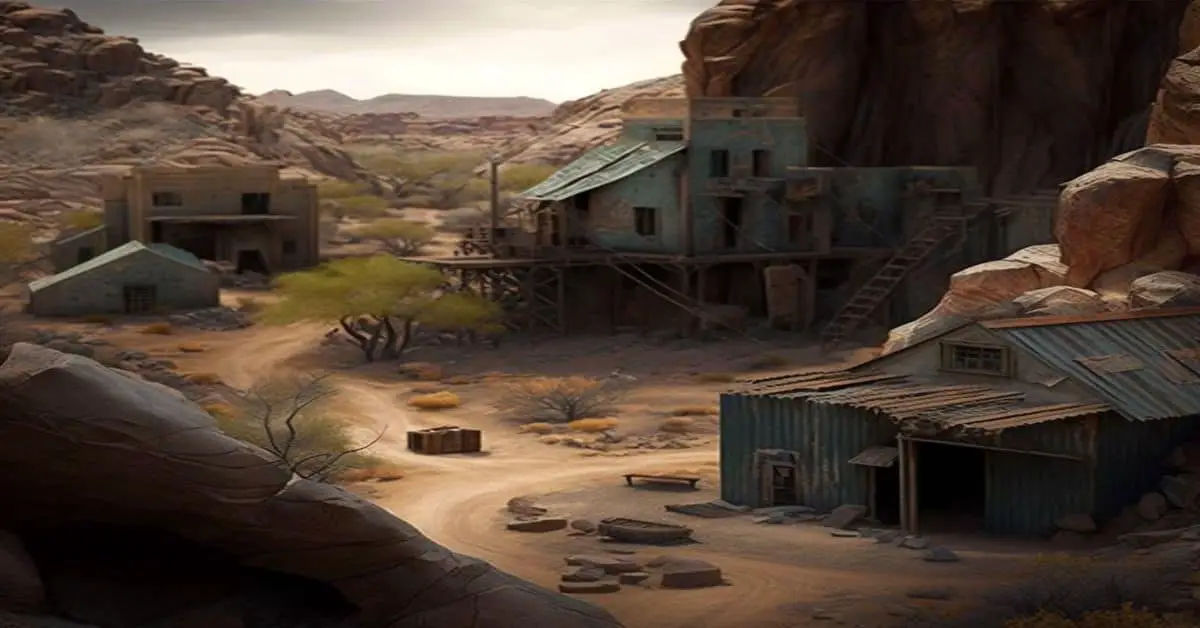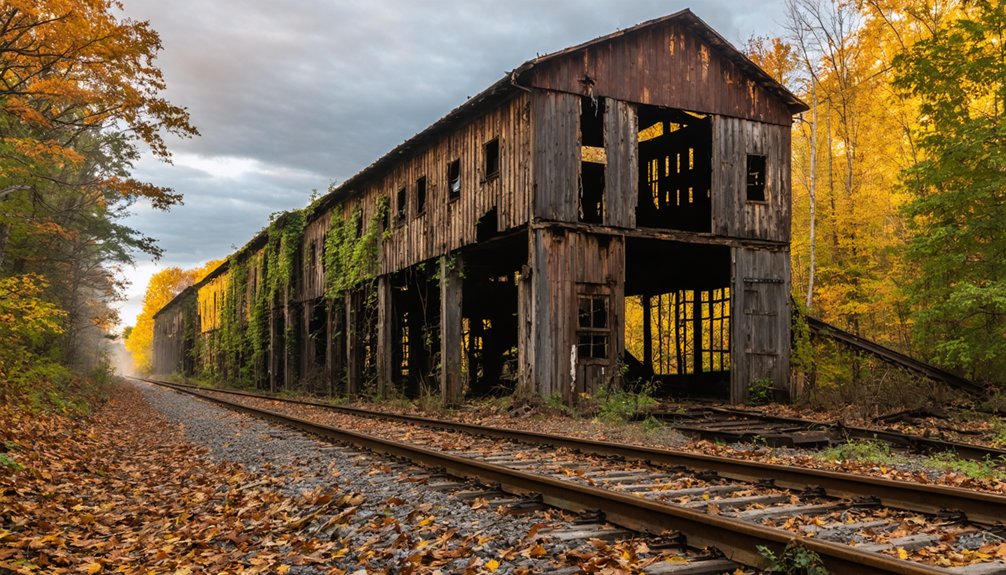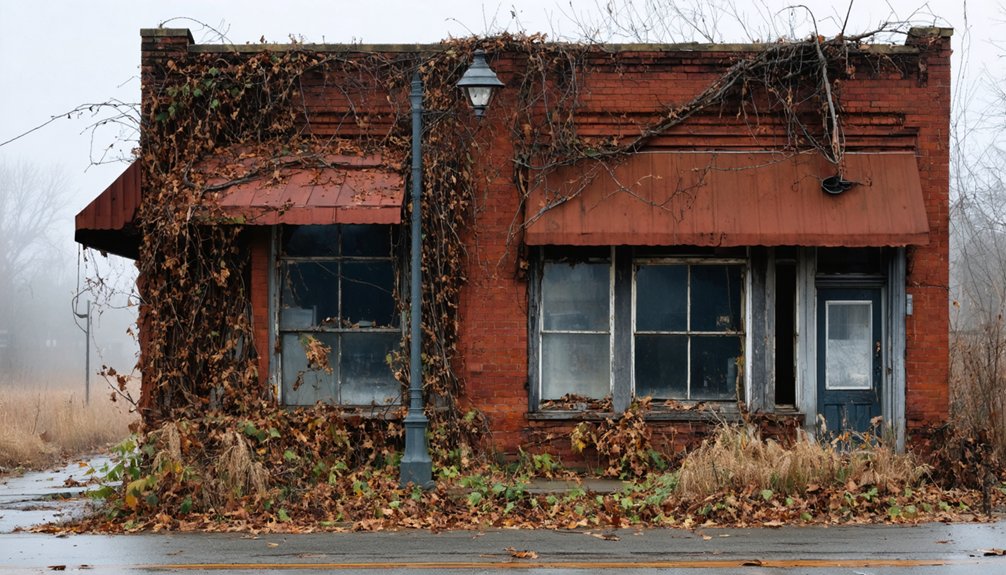You’ll find Heath, Indiana perched on a scenic 669-foot bluff overlooking Wildcat Creek in Perry Township, Tippecanoe County. This ghost town‘s brief but impactful existence centered around its post office operations from 1888 to 1902, serving approximately 150 households during its peak. Today, you can explore the weathered remnants of this former settlement, where nature has begun reclaiming abandoned structures. The town’s connection to railroad history and local folklore holds fascinating untold stories.
Key Takeaways
- Heath was an Indiana settlement located at 40°27’41″N 86°44’00″W, situated on a scenic bluff overlooking Wildcat Creek at 669 feet elevation.
- The town flourished briefly during 1888-1902 when it operated a post office, serving approximately 150 households in the area.
- By 1913, Heath’s population fell below 100 residents as younger people moved to urban areas for better employment opportunities.
- The community’s decline paralleled reduced railroad services and route abandonment, leading to the systematic closure of essential town services.
- Today, only a few weathered structures remain amid nature’s reclamation, marking Heath’s status as one of Indiana’s ghost towns.
Location and Geographic Features
Perched atop a scenic bluff overlooking Wildcat Creek, Heath, Indiana sits at 40°27’41” North and 86°44’00” West within Perry Township, Tippecanoe County.
You’ll find this ghost town at an elevation of 669 feet above sea level, where its geographic significance stems from its strategic position above the waterway. Like many of Nevada’s ghost town remnants, the location preserves traces of its past inhabitants.
The site’s environmental factors reflect typical Midwestern features, with the surrounding terrain showcasing the region’s characteristic rolling hills and creek valleys. The area’s soil composition of acidic, infertile soil mirrors conditions found in natural heathland environments.
The creek’s presence below the bluff hasn’t just shaped the local hydrology – it’s influenced settlement patterns and provided vital water resources.
While you won’t find an active community here today, the remaining buildings stand as evidence of Heath’s past, with the natural landscape largely preserved due to minimal urban development.
Brief Historical Timeline
You’ll find Heath’s origins in the early settlement days of Indiana, where pioneers established a small farming community in the 1800s. The Northwest Territory settlement brought more families to the region after 1787.
The town reached its peak during the post office era, which operated from 1888 to 1902, serving as a crucial communication hub for local residents. Local stories tell of mysterious encounters near an old Crybaby Bridge located on the outskirts of town.
Heath’s decline accelerated after the closure of its post office in 1902, leading to a gradual exodus of residents and eventual abandonment of the settlement.
Early Settlement Days (1800s)
During the early 1800s, Heath emerged as a modest settlement in Perry Township along a scenic bluff overlooking Wildcat Creek, positioned at coordinates 40°27’41” N latitude and 86°44’00” W longitude.
As part of central Indiana’s early settlement patterns, the town reflected the region’s agricultural practices with its 669-foot elevation providing an advantageous view of the surrounding farmland.
You’ll find that Heath never grew into a bustling hub, remaining a small collection of essential buildings serving local farming needs.
Unlike other Indiana towns that developed mills or significant industries, Heath maintained its rural character.
While nearby towns absorbed county administrative roles and commercial activities, Heath’s development stayed limited, following the common trajectory of many small Indiana settlements that would eventually fade into history.
Like many of Indiana’s 49 ghost towns, Heath’s historical records remain sparse due to the low literacy rates of early settlers.
Similar to the fate of Hindostan, many small Indiana settlements suffered from mysterious illnesses that contributed to their eventual abandonment.
Post Office Operations (1888-1902)
The Babcock post office marked Heath’s most active period, opening on January 7, 1889, alongside the Baltimore & Ohio Railroad station’s construction.
As a crucial communication hub, it served the town’s residents and businesses during an era when postal service was the primary means of long-distance contact.
You’ll find that the post office’s operations were closely tied to the railroad’s presence, with mail likely transported by train during its daily routes.
Though the building no longer exists, its establishment symbolized Heath’s brief prosperity.
While records don’t specify exact closure dates or postmaster details, the office provided essential mail collection and distribution services until the early 1900s.
The post office’s eventual closure mirrored the fate of many small railroad towns, marking Heath’s gradual decline into ghost town status.
The office served approximately 150 households before its discontinuation in 1904, reflecting the small but vital community it supported during its operation.
As part of the nationwide expansion of postal routes in the 19th century, Heath’s post office benefited from the Railway Mail Service which began sorting mail directly on trains in 1869.
Final Town Decline Period
While Heath showed promising growth in the late 1880s, its decline began shortly after the turn of the century, following a pattern common to many Indiana railroad towns.
The economic shifts that marked Heath’s community decline became evident through:
- The closure of the post office in 1902, signaling diminishing communication needs
- The exodus of younger residents to urban areas with better employment prospects
- The systematic shutdown of essential services like the general store and blacksmith
You’d have witnessed the town’s gradual abandonment as transportation routes bypassed the area and neighboring communities attracted more commerce. Similar to how Old English relocated due to flooding, Heath’s residents sought better opportunities elsewhere.
By the early 20th century, Heath had lost its economic viability, with families relocating to places offering better opportunities.
Much like Gary’s decline from 180,000 residents to half that population today, the departure of residents accelerated the closure of schools and social institutions, ultimately leading to the town’s complete abandonment.
The Rise and Fall of Heath
You’ll find Heath’s trajectory closely tied to its post office operations, which began in 1888 and ended abruptly in 1902, marking both the community’s peak and the start of its decline.
The settlement’s isolation from railroad routes proved devastating, as neighboring towns with rail connections drew away potential growth and commerce.
Heath’s final years saw its remaining residents relocate to better-connected communities, leading to its eventual abandonment and classification as a ghost town.
Post Office Operations Timeline
Documenting Heath’s post office operations presents significant historical challenges due to limited primary sources and its absence from National Archives postal records.
Like many small rural mail stations of Indiana’s frontier era, Heath’s post office history remains largely speculative, leaving researchers to piece together fragments from broader regional patterns.
Key aspects of Heath’s postal timeline likely included:
- Initial establishment as a basic one-room operation, similar to other 19th-century frontier post offices.
- Limited service hours with mail delivery dependent on stagecoach or horseback routes common in rural Indiana.
- Eventual discontinuation, probably due to population decline or economic shifts that affected many small Indiana communities.
You won’t find Heath in USPS databases or commemorative records, suggesting its postal operations were either remarkably brief or too minor to warrant federal documentation.
Railroad Impact Analysis
Because Heath’s prosperity hinged on its strategic railroad position, the town’s rise and eventual decline closely mirrored the evolving fortunes of Indiana’s rail network.
You’ll find that railroad innovation flourished in Heath during the late 19th and early 20th centuries, as multiple rail lines converged to create an essential agricultural shipping hub.
Samuel Insull’s creation of the Indiana Railroad in 1930-31 briefly modernized freight transportation through consolidation of six interurban companies.
However, you can trace Heath’s downfall to the 1930s, when the Great Depression, combined with growing automobile ownership and improved highways, devastated rail operations.
The town couldn’t survive as railroads cut services, abandoned unprofitable routes, and shifted away from the interurban model that had once made Heath an important regional connector.
Community’s Final Years
The final chapter of Heath’s story unfolded alongside its declining railroad prominence, revealing a community unable to adapt to the changing times.
By 1913, fewer than 100 residents remained, their community memories fading with each passing year. The social decline became evident through:
- The closure of the post office in 1902, severing a crucial communication lifeline
- The disappearance of schools, churches, and gathering places that once united the townspeople
- The gradual exodus of families seeking opportunities in more prosperous areas
You’ll find Heath’s demise mirrors many Indiana ghost towns of the era, caught in the unstoppable tide of urbanization.
The town’s position atop a bluff overlooking Wildcat Creek, once an advantage, couldn’t save it from becoming another casualty of progress and changing economic realities.
Surviving Structures and Remnants
Modern visitors to Heath, Indiana will find only a handful of residential buildings still standing, with commercial structures particularly absent from the landscape.
These historical remnants offer you a glimpse into the town’s rural past, with their simple architectural significance reflecting the modest lifestyle of former residents. You’ll notice nature steadily reclaiming these abandoned structures, with vegetation growing freely around and sometimes through the remaining buildings.
As you explore the site, you’ll see how time and neglect have taken their toll on the surviving structures. The houses that remain serve as silent witnesses to Heath’s decline, their weathered facades and deteriorating conditions telling the story of a community that gradually disappeared.
Many buildings have succumbed to erosion and the elements, leaving behind only foundations or partial walls.
Life in 19th Century Heath
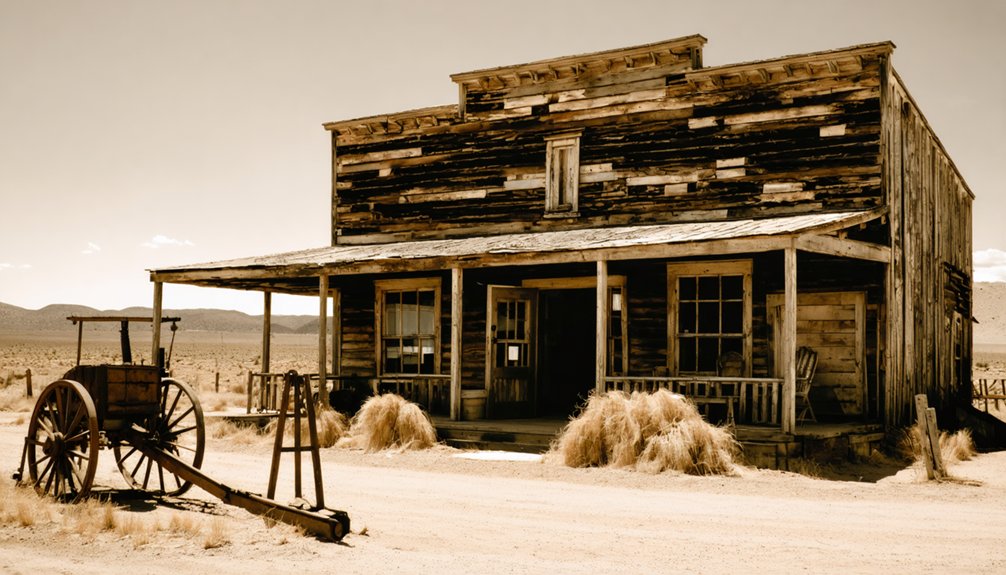
Life in nineteenth-century Heath mirrored the broader patterns of Indiana’s pioneer settlements, where agricultural pursuits dominated daily activities. You’d have found a tight-knit community defined by pioneer culture, where settlers worked together to overcome the challenges of frontier life.
- You’d have spent your days tending to crops and livestock, participating in communal harvests that strengthened bonds between neighbors.
- Your social life would’ve centered around the local church and community gatherings, where agricultural practices and experiences were shared.
- You’d have relied on nearby rivers for trade and transportation, while developing crafting skills to supplement your farming income.
The settlement’s diverse mix of settlers from the South, Mid-Atlantic, and New England brought varied traditions that shaped Heath’s unique character, though daily life remained focused on agricultural survival and community cooperation.
Regional Impact and Significance
Despite its brief existence, Heath emerged as one of Indiana’s 41 documented ghost towns, situated strategically on a bluff overlooking Wildcat Creek at 669 feet above sea level.
You’ll find its story mirrors many other Midwestern settlements that faded due to economic factors, particularly the lack of railroad access that proved essential for sustained growth.
While Heath’s cultural significance might seem limited, its remaining structures offer rare glimpses into 19th-century rural Indiana life.
Unlike ghost towns abandoned due to natural disasters or health crises, Heath’s quiet decline represents a common pattern of rural exodus during urbanization.
Though it didn’t leave a major economic footprint, Heath’s coordinates (40°27’41″N, 86°44’00″W) and documented history guarantee its place in academic studies of American settlement patterns.
Modern-Day Site Exploration
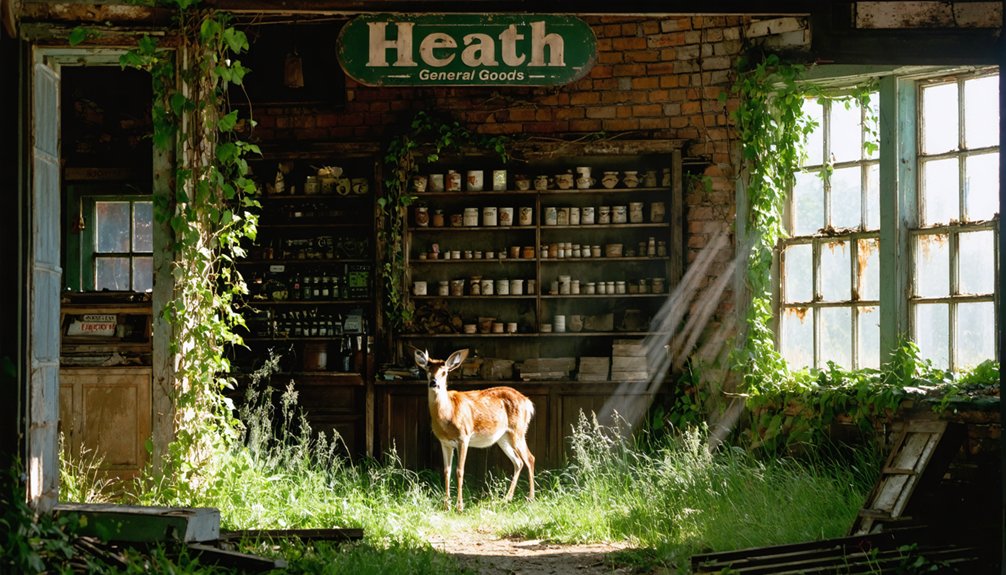
Visiting Heath’s abandoned site today requires careful navigation using the coordinates 40.461389, -86.733333, as you’ll find the remaining structures scattered across the bluff overlooking Wildcat Creek.
The ghostly remains of Heath await atop a scenic bluff, where crumbling structures overlook the winding path of Wildcat Creek below.
As an urban exploration destination, this Indiana ghost town offers a unique glimpse into rural history, though access considerations and structural safety demand attention.
For the modern explorer, Heath presents three key attractions:
- Historic architectural remnants from the late 1800s, including buildings that have withstood over a century of Indiana weather
- Strategic positioning atop a scenic bluff with commanding views of Wildcat Creek’s natural landscape
- Research opportunities through USGS documentation and local historical records that illuminate the site’s evolution from active settlement to ghost town
Bring appropriate gear and respect private property boundaries during your visit.
Preservation Status and Legacy
While Heath’s physical structures continue to slowly fade into the Indiana landscape, its status as a ghost town remains officially documented in USGS geographic records and local historical databases.
You’ll find no extensive preservation efforts here, unlike other Indiana ghost towns such as Elkinsville with its maintained gardens and monuments.
The town’s historical significance lives on primarily through academic studies and cartographic references, telling the story of a brief but remarkable chapter in Tippecanoe County’s development.
Heath’s post office operated from 1888 to 1902, marking a short-lived rural settlement that reflects the broader pattern of Midwestern town extinction.
Today, it serves as a compelling example of how economic shifts and population changes can transform thriving communities into silent historical markers.
Frequently Asked Questions
Were Any Notable Crimes or Mysterious Events Reported in Heath’s History?
You won’t find any documented unsolved mysteries or ghost sightings in the records. Research shows no notable crimes or mysterious events were officially reported in this location’s history.
What Was the Peak Population of Heath During Its Most Active Period?
Like 90% of Indiana’s ghost towns, Heath’s exact peak population statistics remain unknown. While there’s no official historical documentation, research suggests you’re looking at fewer than 100 residents during its mining heyday.
Did Heath Have a School System or Educational Facilities?
You won’t find definitive records of educational institutions or school history in Heath. While Indiana’s rural communities typically had one-room schoolhouses, there’s no direct evidence of educational facilities here.
What Types of Businesses and Industries Operated in Heath?
While you might expect a railroad-driven local economy, Heath operated with minimal commerce. You’ll find no evidence of major industries, just small subsistence farming and basic rural activities.
Why Was the Specific Location Chosen for Establishing Heath?
You’ll find the location’s significance lies in its strategic position atop a bluff overlooking Wildcat Creek, offering natural defense, flood protection, water access, and visibility—critical advantages in the historical context of 1856 settlement.
References
- https://www.youtube.com/watch?v=45D4dbASJyE
- https://www.indystar.com/story/news/history/2019/10/25/indianas-ghost-towns-phantoms-past/3907908002/
- https://www.wikiwand.com/en/articles/Heath
- https://en.wikipedia.org/wiki/Heath
- https://wkdq.com/southern-indiana-ghost-towns/
- http://ingenweb.org/intippecanoe/ghosttowns.htm
- http://ingenweb.org/inlawrence/abandoned.htm
- https://en.wikipedia.org/wiki/List_of_ghost_towns_in_Indiana
- https://kids.kiddle.co/List_of_ghost_towns_in_Indiana
- https://www.reviewjournal.com/local/local-nevada/abandoned-but-not-forgotten-5-ghost-towns-in-southern-nevada-3351038/

